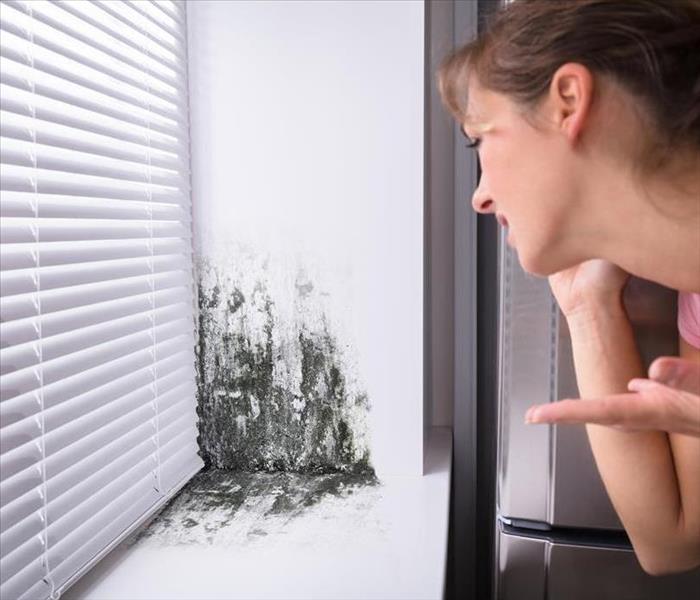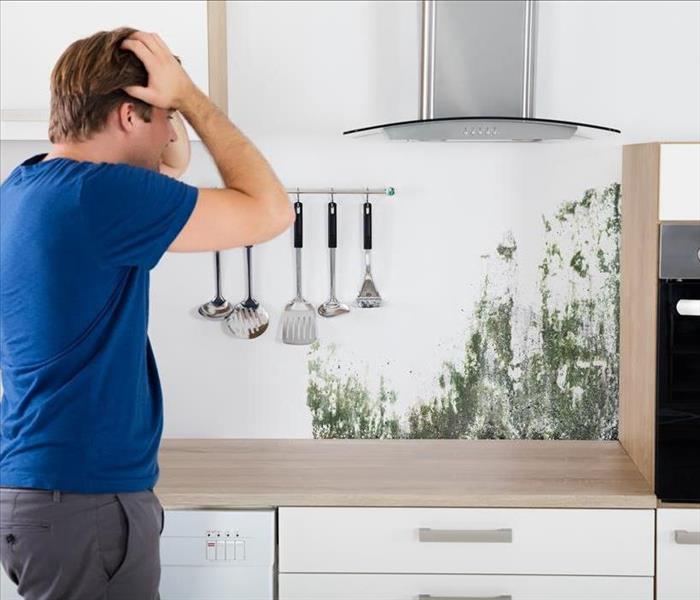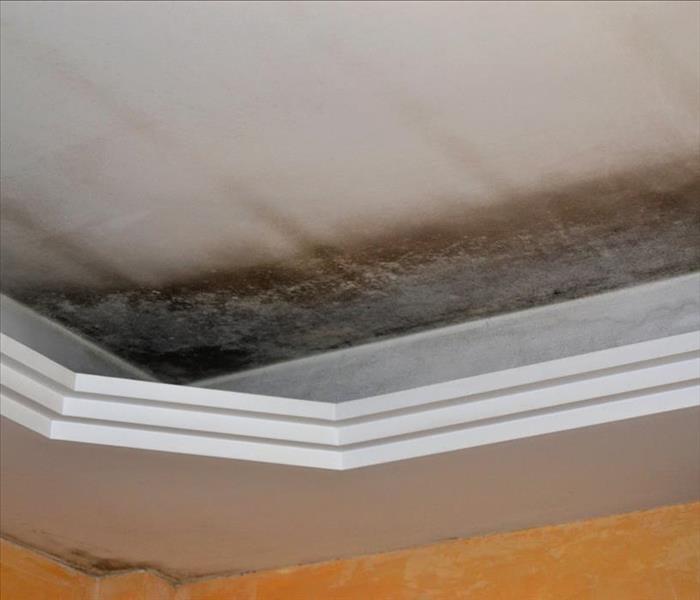Recent Mold Remediation Posts
Where Mold Grows Inside Your Home
3/24/2022 (Permalink)
 Prevent Mold Growth Inside Your Home by Following Our Tips.
Prevent Mold Growth Inside Your Home by Following Our Tips.
It's a frustrating reality that mold damage can happen to anyone. The expense and inconvenience of setting the situation right will worsen with every passing day. For this reason, you should be on the lookout for mold in areas where it is most likely to appear. By detecting mold growth quickly, you can stop the problem from mushrooming into a much bigger problem.
Why You Do Not Want Mold Damage
Repairs are costly and can take weeks or even months to complete. No room is safe. The longer you wait to eliminate the problem, the worse it will get. Immediately hire a professional to solve the matter.
Where To Find Mold in Kitchens
The presence of food combined with heat and moisture makes this area particularly susceptible to fungal invaders. You can reduce the odds of a problem taking shape by:
- Washing dishes immediately
- Taking out the trash
- Cleaning the stove, microwave, and counters
- Ventilating while cooking
Make sure others in your household know the importance of handling these tasks. Post reminders in relevant spots so they cannot use the excuse of forgetting.
Remember to look under sinks, where leaky pipes create pools of moisture that cultivate mold. The darkness in these spaces boosts the odds of a moldy patch emerging.
Inspect your refrigerator and pantry. Be vigilant about tossing items past their expiration dates so that nothing destructive has an opportunity to develop.
Where To Find Mold in Bathrooms
Fixing your commode might be difficult. The challenge of replacing tiles is often more than someone without remodeling experience can handle. A better alternative is to hire a mold renovation specialist. The optimal outcome is preventing the matter from advancing to that point through early detection.
Examine showers and tubs for signs of mold. If you detect any, scrub the zone with white vinegar. Turn over rugs and check for funky colors. Behind the toilet is another spot where it sometimes hides. Hire a plumber to correct any leakages as soon as possible.
Where To Find Mold in Bedrooms
The place where you rest your head might seem immune to gathering mold. However, there are several spaces where it sometimes gathers. Mattresses, for instance, are breeding grounds for fungal interlopers. Fight this concern by choosing one that's mold-resistant.
Air conditioners and heating units collect mold, too. Periodically peer inside the vents. If you see signs of discoloration, call a professional immediately.
Depending on the climate in South Boston, VA, your windows may be a source of trouble. Cracks mean raindrops can get inside when storms happen. Wooden sills are particularly susceptible to fungal rot.
Where To Find Mold in Living Rooms
Many variables increase the odds that fungi appear in these rooms. The presence of plants is one. Spores love to grab hold of them. Be vigilant about trimming leaves showing signs of mildew growth. Also, inspect curtains and upholstered furniture. Don't forget about fireplaces, where brick facilitates rapid mold growth.
Mold damage is limited when you take swift action. Look in areas where it's likely to appear, and hire an expert the moment it's detected.
Where Mold Grows Inside Your Home
3/24/2022 (Permalink)
 Prevent Mold Growth Inside Your Home by Following Our Tips.
Prevent Mold Growth Inside Your Home by Following Our Tips.
It's a frustrating reality that mold damage can happen to anyone. The expense and inconvenience of setting the situation right will worsen with every passing day. For this reason, you should be on the lookout for mold in areas where it is most likely to appear. By detecting mold growth quickly, you can stop the problem from mushrooming into a much bigger problem.
Why You Do Not Want Mold Damage
Repairs are costly and can take weeks or even months to complete. No room is safe. The longer you wait to eliminate the problem, the worse it will get. Immediately hire a professional to solve the matter.
Where To Find Mold in Kitchens
The presence of food combined with heat and moisture makes this area particularly susceptible to fungal invaders. You can reduce the odds of a problem taking shape by:
- Washing dishes immediately
- Taking out the trash
- Cleaning the stove, microwave, and counters
- Ventilating while cooking
Make sure others in your household know the importance of handling these tasks. Post reminders in relevant spots so they cannot use the excuse of forgetting.
Remember to look under sinks, where leaky pipes create pools of moisture that cultivate mold. The darkness in these spaces boosts the odds of a moldy patch emerging.
Inspect your refrigerator and pantry. Be vigilant about tossing items past their expiration dates so that nothing destructive has an opportunity to develop.
Where To Find Mold in Bathrooms
Fixing your commode might be difficult. The challenge of replacing tiles is often more than someone without remodeling experience can handle. A better alternative is to hire a mold renovation specialist. The optimal outcome is preventing the matter from advancing to that point through early detection.
Examine showers and tubs for signs of mold. If you detect any, scrub the zone with white vinegar. Turn over rugs and check for funky colors. Behind the toilet is another spot where it sometimes hides. Hire a plumber to correct any leakages as soon as possible.
Where To Find Mold in Bedrooms
The place where you rest your head might seem immune to gathering mold. However, there are several spaces where it sometimes gathers. Mattresses, for instance, are breeding grounds for fungal interlopers. Fight this concern by choosing one that's mold-resistant.
Air conditioners and heating units collect mold, too. Periodically peer inside the vents. If you see signs of discoloration, call a professional immediately.
Depending on the climate in South Boston, VA, your windows may be a source of trouble. Cracks mean raindrops can get inside when storms happen. Wooden sills are particularly susceptible to fungal rot.
Where To Find Mold in Living Rooms
Many variables increase the odds that fungi appear in these rooms. The presence of plants is one. Spores love to grab hold of them. Be vigilant about trimming leaves showing signs of mildew growth. Also, inspect curtains and upholstered furniture. Don't forget about fireplaces, where brick facilitates rapid mold growth.
Mold damage is limited when you take swift action. Look in areas where it's likely to appear, and hire an expert the moment it's detected.
Can Business Owners Be Sued for Mold Growth?
9/20/2021 (Permalink)
 Mold grows in moisture environments in your company in Emporia, VA.
Mold grows in moisture environments in your company in Emporia, VA.
Because mold can damage buildings and personal property, mold insurance claims and lawsuits are sometimes filed against building owners, contractors, and other types of businesses because of mold damage. This guide provides an overview of what you need to know about mold growth lawsuits.
What Is Mold?
Molds are a type of naturally occurring fungi found in most indoor and outdoor environments. The thousands of different species reproduce by creating spores that travel to different locations through the air. Mold needs oxygen and moisture to grow and is often found in damp environments:
- Wet foundations
- Areas with leaking pipes
- Surfaces with condensation
- Buildings with poor ventilation
- Spaces with poor air circulation
When Can Businesses Be Liable for Damages?
Businesses are sometimes liable for mold-related damages suffered by customers, tenants, employees, or others. Some types of businesses are more likely to experience a mold claim than others. Examples include property managers, landlords, architects, contractors, and structural engineers.
When Can Landlords or Property Managers Be Sued for Mold Damages?
Most states require residential landlords to maintain the rental property in habitable condition. If a landlord or property manager fails to take proper mold remediation steps, such as contacting a mold remediation company in Emporia, VA, to remove mold growth, and a tenant's property is damaged because of a mold infestation, the landlord may be liable for damages. The landlord may also be liable for expenses incurred by a tenant who must move out of a rental that is not safe to live in because of mold. Commercial landlords are generally not held to as high a standard but may be subject to mold insurance claims if their negligence causes the building to become unfit for its intended use.
When Can Contractors Be Sued for Mold Damages?
Because water damage can lead to mold growth, contractors may be sued if defects in their work cause water leaks or other problems that contribute to mold infestations. Claims against contractors usually result from allegations that the contractor used the wrong types of materials, installed materials incorrectly, or caused damage during the construction process that led to the mold problem.
When Can Architects and Structural Engineers Be Sued for Mold Damages?
Structural engineers and architects may be liable for damages when the design of a building or its systems results in excessive moisture that contributes to mold growth. Claims may arise if the mold growth causes damage to the claimant's property.
How Can Business Owners Avoid Mold Lawsuits?
Taking steps to prevent mold from growing is the most important strategy for avoiding lawsuits. Building owners should regularly check buildings for sources of moisture, such as condensation, leaks, poor drainage, and faulty window seals. Ventilation and HVAC systems should also be regularly inspected. When problems are found, take immediate action to dry out wet properties and fix the source of the excess moisture.
Mold insurance claims and lawsuits can result when business owners fail to take appropriate steps to prevent mold infestations. Some commercial insurance policies specifically exclude coverage for mold damage, so it may be a good idea to speak with your insurance professional to ensure you are protected.
Can Business Owners Be Sued for Mold Growth?
9/20/2021 (Permalink)
 Mold grows in moisture environments in your company in Emporia, VA.
Mold grows in moisture environments in your company in Emporia, VA.
Because mold can damage buildings and personal property, mold insurance claims and lawsuits are sometimes filed against building owners, contractors, and other types of businesses because of mold damage. This guide provides an overview of what you need to know about mold growth lawsuits.
What Is Mold?
Molds are a type of naturally occurring fungi found in most indoor and outdoor environments. The thousands of different species reproduce by creating spores that travel to different locations through the air. Mold needs oxygen and moisture to grow and is often found in damp environments:
- Wet foundations
- Areas with leaking pipes
- Surfaces with condensation
- Buildings with poor ventilation
- Spaces with poor air circulation
When Can Businesses Be Liable for Damages?
Businesses are sometimes liable for mold-related damages suffered by customers, tenants, employees, or others. Some types of businesses are more likely to experience a mold claim than others. Examples include property managers, landlords, architects, contractors, and structural engineers.
When Can Landlords or Property Managers Be Sued for Mold Damages?
Most states require residential landlords to maintain the rental property in habitable condition. If a landlord or property manager fails to take proper mold remediation steps, such as contacting a mold remediation company in Emporia, VA, to remove mold growth, and a tenant's property is damaged because of a mold infestation, the landlord may be liable for damages. The landlord may also be liable for expenses incurred by a tenant who must move out of a rental that is not safe to live in because of mold. Commercial landlords are generally not held to as high a standard but may be subject to mold insurance claims if their negligence causes the building to become unfit for its intended use.
When Can Contractors Be Sued for Mold Damages?
Because water damage can lead to mold growth, contractors may be sued if defects in their work cause water leaks or other problems that contribute to mold infestations. Claims against contractors usually result from allegations that the contractor used the wrong types of materials, installed materials incorrectly, or caused damage during the construction process that led to the mold problem.
When Can Architects and Structural Engineers Be Sued for Mold Damages?
Structural engineers and architects may be liable for damages when the design of a building or its systems results in excessive moisture that contributes to mold growth. Claims may arise if the mold growth causes damage to the claimant's property.
How Can Business Owners Avoid Mold Lawsuits?
Taking steps to prevent mold from growing is the most important strategy for avoiding lawsuits. Building owners should regularly check buildings for sources of moisture, such as condensation, leaks, poor drainage, and faulty window seals. Ventilation and HVAC systems should also be regularly inspected. When problems are found, take immediate action to dry out wet properties and fix the source of the excess moisture.
Mold insurance claims and lawsuits can result when business owners fail to take appropriate steps to prevent mold infestations. Some commercial insurance policies specifically exclude coverage for mold damage, so it may be a good idea to speak with your insurance professional to ensure you are protected.
Places Where Mold Can Hide in Your Home
6/28/2021 (Permalink)
 Mold growth in Emporia, VA.
Mold growth in Emporia, VA.
Mold is one thing that you never want to see. Unfortunately, it is not necessarily the mold that you can see that is the problem. Mold growth can extend far into places where light does not shine. It is important to know where mold might be so you can eliminate it before it becomes a problem.
Places Where Mold Might Grow in Your Home
Look For Moisture
One of the quickest ways to find hidden mold is to look for moisture. Places that have:
- Poor ventilation
- High humidity
- Leaking pipes
- Flood damage
Each of these is a place where mold is likely to grow. This is not to say that it will not grow elsewhere.
Check Drip Pans
Refrigerator and air conditioner drip pans are other sources of mold. This mold can overgrow the pan, and then you have mold on wood. Once this happens, you might want to consider a professional mold remediation company in Emporia, VA. Both the refrigerator and the air conditioner are two places you don't normally see.
Check Under and Around Windows
Windows are notorious for allowing water in. Mold growth is extremely common in the tracks and around the sills themselves. It is a classic place to look for leaks as well. Where there are leaks, there is often mold.
Behind Drywall
Another place where mold is often lurking is behind drywall. When you have a leak inside one of your walls, it can result in moldy drywall. Although you cannot immediately see it, you might be able to smell it. Moldy growths can result in a musty or earthy smell.
Mold Under Carpets
Another hidden place where mold can grow is underneath your carpet or on the carpet pad. This usually happens when a carpet is wet and not properly dried. When you have mold underneath a carpet, you have to clean the carpet, carpet pad, and wood underneath both.
Mold growth can happen anywhere there is a damp or humid area. Remember, just because you can't see it doesn't mean that it isn't there.
Places Where Mold Can Hide in Your Home
6/28/2021 (Permalink)
 Mold growth in Emporia, VA.
Mold growth in Emporia, VA.
Mold is one thing that you never want to see. Unfortunately, it is not necessarily the mold that you can see that is the problem. Mold growth can extend far into places where light does not shine. It is important to know where mold might be so you can eliminate it before it becomes a problem.
Places Where Mold Might Grow in Your Home
Look For Moisture
One of the quickest ways to find hidden mold is to look for moisture. Places that have:
- Poor ventilation
- High humidity
- Leaking pipes
- Flood damage
Each of these is a place where mold is likely to grow. This is not to say that it will not grow elsewhere.
Check Drip Pans
Refrigerator and air conditioner drip pans are other sources of mold. This mold can overgrow the pan, and then you have mold on wood. Once this happens, you might want to consider a professional mold remediation company in Emporia, VA. Both the refrigerator and the air conditioner are two places you don't normally see.
Check Under and Around Windows
Windows are notorious for allowing water in. Mold growth is extremely common in the tracks and around the sills themselves. It is a classic place to look for leaks as well. Where there are leaks, there is often mold.
Behind Drywall
Another place where mold is often lurking is behind drywall. When you have a leak inside one of your walls, it can result in moldy drywall. Although you cannot immediately see it, you might be able to smell it. Moldy growths can result in a musty or earthy smell.
Mold Under Carpets
Another hidden place where mold can grow is underneath your carpet or on the carpet pad. This usually happens when a carpet is wet and not properly dried. When you have mold underneath a carpet, you have to clean the carpet, carpet pad, and wood underneath both.
Mold growth can happen anywhere there is a damp or humid area. Remember, just because you can't see it doesn't mean that it isn't there.




 24/7 Emergency Service
24/7 Emergency Service


